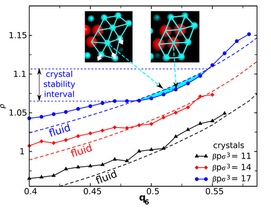Research Abstract
過冷却液体における結晶化への微視的経路
The microscopic pathway to crystallization in supercooled liquids
2012年7月12日 Scientific Reports 2 : 505 doi: 10.1038/srep00505

結晶化過程の微視的な理解は、その基礎的・工学的な重要性にもかかわらず、依然として十分とは言えない。我々は、剛体球モデルのコンピューター・シミュレーションを用いて、熱揺らぎが過冷却液体状態から結晶状態への転移を駆動するメカニズムを明らかにした。特に我々は、密度揺らぎによって転移が始まるという一般的な考えに反して、ボンド配向秩序の揺らぎが核形成過程の引き金となっていることを突き止めた。さらに、ボンド配向秩序の揺らぎを解析した結果、その揺らぎが、核形成過程の種としての役割を果たすばかりでなく、i)将来核形成される特定の結晶形を決定すること、また、ii)高密度においては5回対称構造の形成を促し、その結果結晶形成を阻害することが明らかになった。これらの結果から、結晶化とガラス化の関係を理解する手がかりが得られる可能性がある。
John Russo1 & 田中 肇1
- 東京大学 生産技術研究所
Despite its fundamental and technological importance, a microscopic understanding of the crystallization process is still elusive. By computer simulations of the hard-sphere model we reveal the mechanism by which thermal fluctuations drive the transition from the supercooled liquid state to the crystal state. In particular we show that fluctuations in bond orientational order trigger the nucleation process, contrary to the common belief that the transition is initiated by density fluctuations. Moreover, the analysis of bond orientational fluctuations shows that these not only act as seeds of the nucleation process, but also i) determine the particular polymorph which is to be nucleated from them and ii) at high density favour the formation of fivefold structures which can frustrate the formation of crystals. These results can shed new light on our understanding of the relationship between crystallization and vitrification.

